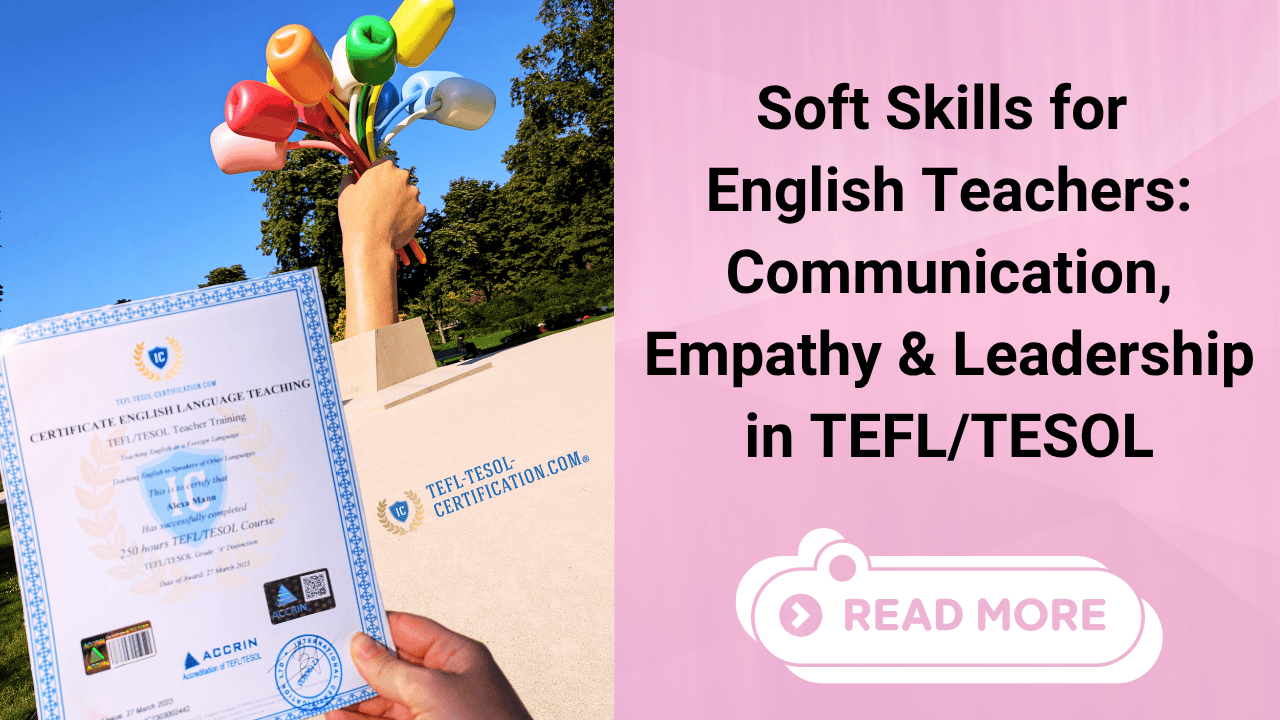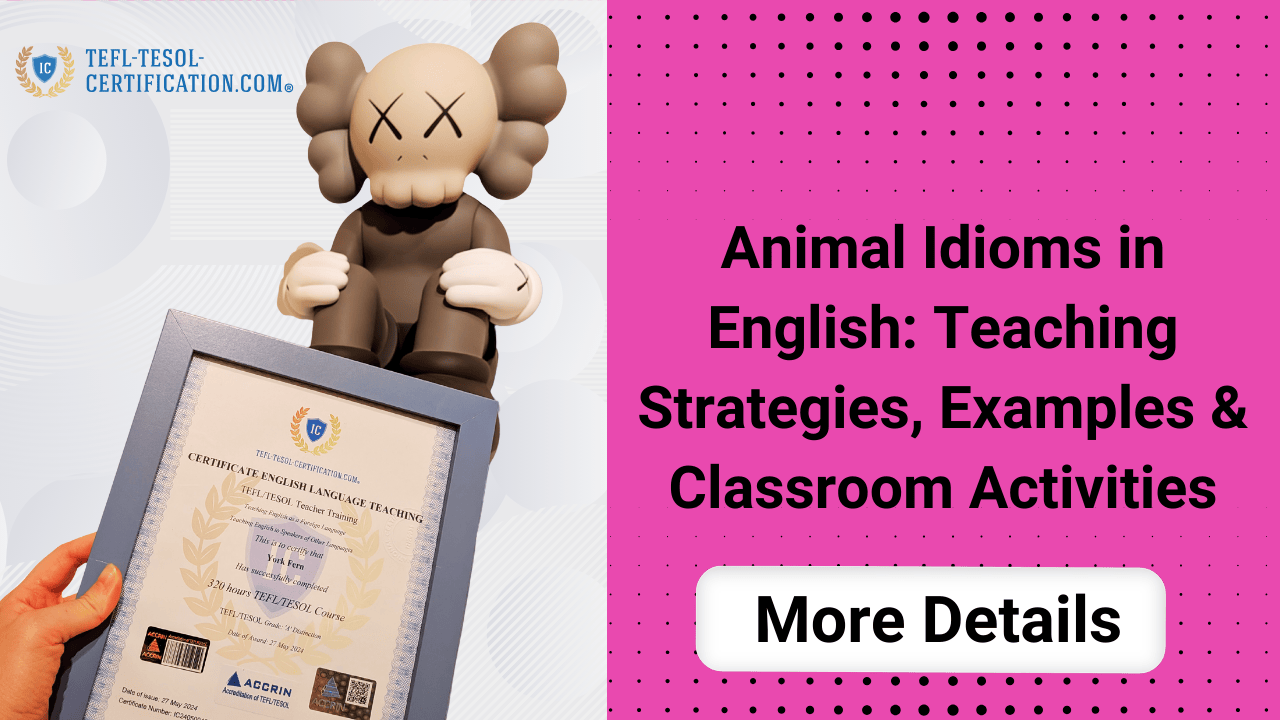And start earning money 💸 by teaching English in your own country, abroad, or online from anywhere on the planet! 🎁 Gifts and bonuses: professional support from your personal coach 🧑🏫 and job placement assistant 💼.

Soft Skills for English Teachers: Communication, Empathy & Leadership in TEFL/TESOL
Table of contents
- Why developing soft skills is a strategic advantage for English teachers
- Teacher communication skills: structure and training
- Empathy in teaching: how to listen without burning out
- Teacher leadership: values, boundaries, and rituals
- How to integrate soft skills for English teachers into your program and career
- Tools and rhythms that make teaching easier
- Common mistakes to avoid
- Final thoughts: soft skills are part of your profession, not an add-on
Have you ever wondered why two lessons with the same plan bring completely different results? The answer often lies in the development of a teacher’s soft skills. When we grow our soft skills as English teachers, every plan starts to “breathe”: the class listens, trusts, and moves forward — you can literally feel it in the air. 😊
Why developing soft skills is a strategic advantage for English teachers
I’m York Fern, and after 12+ years of teaching hundreds of students, one of the most common questions from colleagues is: “Where can I find time for soft skills when I already have so much to do?” I understand. But these very skills actually save time: fewer conflicts, clearer instructions, faster progress. In TEFL and TESOL training, this is often called “teaching mastery” — a flexible blend of communication, empathy, and leadership.
- Communication makes lesson goals as clear as a short roadmap.
- Empathy senses the group’s energy and fear of making mistakes.
- Leadership sets the boundaries where it’s safe to work and grow.
Want something practical and no-nonsense? Let’s break it down and look at techniques you can start using tomorrow. 🎯
What soft skills mean in TEFL & TESOL teaching
TEFL stands for Teaching English as a Foreign Language, and TESOL means Teaching English to Speakers of Other Languages. In both frameworks, soft skills aren’t a “bonus” — they’re the foundation: clear speech, active listening, flexible feedback, and classroom management.
- Use sensory awareness: when the marker squeaks on the board, pause and let your students process the question.
- Keep rhythm: give short instructions → demonstrate → check understanding → practice → quick reflection.
Teacher communication skills: structure and training
When I started teaching, my mentor told me: “York, your plan is perfect, but your students are lost.” I wrote down five habits — and they’ve guided me ever since.
- Check-in at the start (1 minute): “One win, one worry.” Everyone shares one success and one goal for the lesson.
- The 10-second rule: pause after a question — let silence work for you. 💡
- Pyramid instructions: go from general to specific, no more than three steps.
- Echo phrasing: “So your task is…” — repeat the student’s request using their own words.
- Visual anchors: use a timer, checklist, or model answer on the screen.
Quick teacher’s lounge dialogue: “York, how do you manage to keep timing?” — “I don’t rush. I just remove extra words.” Short means clear.
Scenarios: in-person and online
- In-person: use “walk-and-talk” — change pairs every 2–3 minutes; keep your tone calm and phrases short.
- Online: try the “green mic rule” — when the mic icon lights up, say one sentence and pass it on.
- For both: finish instructions with a check question: “What do we do first?” — “Open the text.” Perfect.
| Skill | What students notice | How to train |
| Clear instructions | They understand the task the first time | Use 3-step visuals, a timer, and an example |
| Active listening | Their thoughts aren’t interrupted | Paraphrase, ask follow-ups, pause |
| Feedback | They know what’s improving | “Two stars & a wish” — two strengths and one target |
Empathy in teaching: how to listen without burning out
Empathy isn’t pity — it’s fine-tuned awareness of your students’ rhythm and emotions.
- Emotional barometer: at the start, ask for a rating from 1–5; at the end, one verb describing their mood (“improve,” “struggle,” “enjoy”).
- Human before task: “Feeling tired? Let’s do five minutes in pairs and then wrap up.”
- Safe mistake: normalize errors — “mistakes = data.”
Five quick empathy practices
- Replace “How are you?” with “What will success look like for you today?”
- Agree on gestures for “slow down” and “repeat” — it saves words.
- Offer choice: activity A or B (both lead to the same goal, different routes).
- Separate result from identity: “The answer is incorrect” ≠ “You are incorrect.”
- Celebrate micro-progress: note one correct verb or structure at the end. 🚀
Teacher leadership: values, boundaries, and rituals
Leadership isn’t about strict tone — it’s calm strength. When you enter the classroom, the frame is already there: rules are clear, goals are visible, timing is set. Students feel safe, and you feel in control.
- Visible values: respect, participation, and freedom to make mistakes — write and discuss them.
- Boundaries: “We challenge ideas, not people.” A simple rule that saves discussions.
- Rituals: a 60-second focus to start, and “one takeaway” at the end.
- Group roles: assign “timekeeper,” “scribe,” and “speaker” — every lesson.
- The +1 rule: each student adds one detail to the previous answer.
Mini-dialogue: “Can I submit later?” — “Yes, if you inform me beforehand and give a new date.” Calm tone + clear boundary = trust.
🚀 More students, 💰 higher income, 🌍 complete freedom! ✅ 112 verified platforms with top rates ⏳ Flexible schedule – work whenever and as much as you want 🎯 Simple requirements – start earning right away 💎 Boost your career and income by teaching students worldwide!
When to stay flexible and when to stay firm
- Be flexible when the class energy drops — switch pairs to small groups.
- Be firm about values: respect, safety, and honesty are non-negotiable.
- Balance both: “I can rephrase, but we’ll keep the timing.”
How to integrate soft skills for English teachers into your program and career
Soft skills grow faster when supported by methodology. That’s why structured TEFL/TESOL training helps you combine teaching techniques with personal communication and leadership development.
- Integration with TEFL/TESOL: for every module, add one or two soft skill practices — for example, the 10-second rule or emotional barometer.
- Entry level: an Intermediate English level is enough to start practicing communication and classroom leadership.
- Action plan: create a 4-week soft skills plan and reflect weekly on what’s improving.
4-Week Development Plan (Tested in Real Classrooms)
This plan helps English teachers gradually build stronger communication, empathy, and leadership skills without overloading their schedule. Each week focuses on one key area with simple, proven activities that can be implemented immediately in any classroom — online or offline.
Week 1: Communication — Pyramid Instructions & the 10-Second Rule
Start with clarity. Every successful lesson begins with instructions that are easy to follow. Use the pyramid model: move from general to specific in no more than three steps. For example, instead of explaining every detail at once, guide students step-by-step — “Read the text → Discuss with a partner → Share one idea.”
Apply the 10-second rule after asking a question. Count silently before calling on someone. That short pause gives students processing time and encourages participation from quieter learners. It’s a small change that dramatically increases engagement and comprehension.
Week 2: Empathy — Emotional Barometer & Choice-Based Activities
Empathy keeps your classroom human. Begin each lesson with an emotional barometer: ask students to rate their mood from 1 to 5 or describe it with a word like “curious,” “tired,” or “motivated.” This simple check-in helps you adjust the lesson’s pace and energy level.
Introduce choice-based activities to build autonomy and trust. Offer two similar exercises — for example, a reading task (A) or a speaking task (B) — both leading to the same learning goal. Giving learners control over how they reach the objective increases motivation and reduces resistance.
Week 3: Leadership — Class Values & “One Takeaway” Ritual
Great teachers lead with calm authority. During this week, work on making your classroom values visible: write 2–3 principles such as “respect,” “effort,” and “freedom to make mistakes” on the board and discuss what they mean in practice. Refer back to them when setting expectations or resolving conflicts.
End each lesson with the “one takeaway” ritual: ask students to name one thing they learned, understood, or want to try next time. This builds reflection habits, closes lessons with clarity, and reinforces your leadership presence without being authoritarian.
Week 4: Integration — Group Roles & “Two Stars & a Wish”
Now it’s time to bring everything together. Assign group roles such as “timekeeper,” “note-taker,” or “speaker” to distribute responsibility evenly and strengthen teamwork. Rotating these roles every lesson helps students develop confidence and communication skills.
End the week by practicing “Two Stars & a Wish” — a quick feedback model where each student shares two positive observations and one area for improvement about their partner’s work. It encourages empathy, active listening, and constructive communication — the perfect blend of all three soft skills developed over the previous weeks.
By the end of this four-week cycle, you’ll notice more confident students, smoother classroom dynamics, and your own growing sense of balance as a teacher. Repeat the plan regularly, adding new micro-practices each month to keep your teaching skills evolving. 🌱
Tools and rhythms that make teaching easier
- Lesson matrix 3×5: 3 stages × 5 minutes — entry, practice, reflection.
- Feedback cards: highlight one strong verb from each student’s speech.
- Timer and checklist: fewer words, more action.
- Micro-progress log: two lines per student per week — visible progress keeps motivation high.
Sensory detail: a warm cup of coffee on the desk, a tiny timer ticking next to it. When it clicks, you smile — the class moves with you, and everyone feels that calm rhythm.
💡 Unlock the secrets to doubling your teaching income with our exclusive checklist! 🎯 This checklist is designed for English teachers who want to 📈 attract more students and 🔥 keep them engaged for the long term.
Common mistakes to avoid
- “Method first, soft skills later.” No — they go hand in hand. Teach grammar through active listening and clear instructions.
- “Empathy means being lenient.” No — empathy is precision and respect, not giving up standards.
- “Leadership equals strictness.” A true leader creates predictability and clarity, not fear.
- “No time.” There’s always a minute: 60 seconds for check-in and 60 for reflection.
Final thoughts: soft skills are part of your profession, not an add-on
When you teach language, you build a bridge. When you grow your soft skills, you invite students to cross it. Five simple habits can transform lessons without overload. Keep one practice per week, and you’ll see your class grow more confident and independent. Calm teacher energy is visible — and that’s the best motivation for your learners. 🚀
Terms used:
TEFL, TESOL

York Fern
An English instructor with 12+ years of experience. I work for an online school and travel the world, teaching students from various countries, leveraging my TEFL/TESOL certification. Seeing the world's oceans, mountains, and cities with my own eyes has given me a profound appreciation for the importance of quality education and international communication.
and start earning by teaching English in your country, abroad, or online from anywhere in the world! Order the course with a 50% discount 💸 and receive as a gift the support of a personal coach 👨🏫 and job placement assistant! 🎁🚀 Hurry, limited spots available! 🏃♂️💨
💡 Unlock the secrets to doubling your teaching income with our exclusive checklist! 🎯 This checklist is designed for English teachers who want to 📈 attract more students and 🔥 keep them engaged for the long term.
🚀 More students, 💰 higher income, 🌍 complete freedom! ✅ 112 verified platforms with top rates ⏳ Flexible schedule – work whenever and as much as you want 🎯 Simple requirements – start earning right away 💎 Boost your career and income by teaching students worldwide!
choose us?



